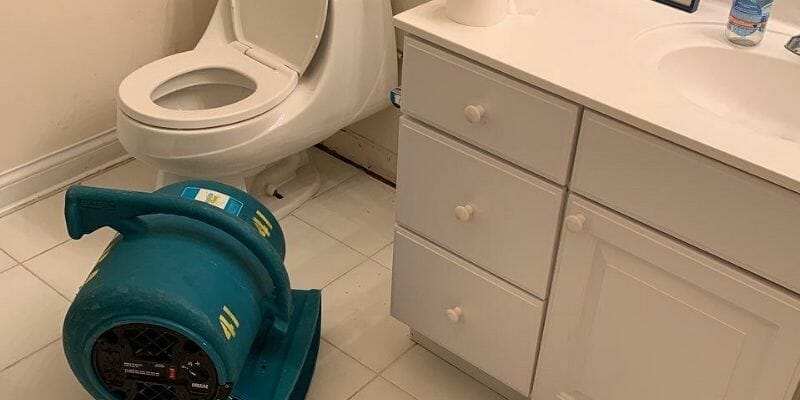You jiggle the handle, but it doesn’t help. The toilet won’t flush. Water rises up, fills the bowl and spills out onto on the bathroom floor.
You’re dealing with an overflowing toilet.
How do you handle this mess before it floods the bathroom? Each day, we help homeowners in Chicago homes recover from these types of issues, so we’re happy to share our expertise!
Read on to find out exactly what you need to do!
What to Do When Your Toilet Overflows: A 5-Step Guide
If you’re not sure about how to fix a toilet that’s overflowing, you’re in good company. The problem isn’t a typical DIY situation. If you know what to do before it happens, it’s much easier to solve.
Follow these five steps to stop the overflow, eliminate the cause and safely clean up the mess.
1. Turn Off the Water

Locate the shut-off valve on the water supply line behind your toilet. Turn it counterclockwise until it’s completely closed. You may also need to remove the tank lid and pull up the float. If the water is still running, turn off the main line coming into your home.
2. Prep the Area
Put old towels around the toilet base and across wet floors. This catches overflow that results from unclogging the toilet. It also reduces the chances of slipping and falling. Bail a few inches of water out of the bowl before you start working.
3. Use the Right Plunger

Make sure you’re using a toilet plunger. Its center flange creates a tight seal around the toilet drain opening. Coat the plunger edges with petroleum jelly, position it over the drain, and start slowly. As you work, increase downward pressure and speed until the clog breaks up.
Power Tip: Using a plunger in a toilet while the water is still overflowing makes the situation worse.
4. Snake Stubborn Clogs
If a plunger doesn’t clear the problem, use a toilet drain snake. This tool is designed to snag clogs and pull them out of the bowl. Ease its hook into the toilet’s S-shaped trap by turning the auger’s crank clockwise.
5. Clean With Caution

Be careful cleaning up a flooded bathroom after a toilet flush overflow. The water is usually contaminated with dangerous bacteria, so follow the best safe practices as you work. You may need to rent a wet vac and heavy duty drying equipment. Follow up cleaning by thoroughly disinfecting all affected surfaces and materials.
Power Tip: Don’t use homemade bleach-based disinfectants on porous surfaces. Instead, treat them with antibacterial spray products, and always follow package instructions.
What Causes a Toilet to Overflow?

It’s good to know how to unclog a toilet, but it’s easier to prevent the problem when you understand why it happens. These are the most common causes of toilet backups.
Clogged Toilet Traps
The S-shaped trap in a toilet base prevents sewer gases from backing up into the bathroom. Its shape also makes it a prime spot for catching things that shouldn’t go down the toilet such as cotton balls, dental floss, facial tissues and even too much toilet paper.
Clogged Drain Pipes
The same things that clog a toilet trap can migrate through the system into the drain pipe. Clearing this type of clog isn’t a DIY project. If you suspect drain pipe blockage, call a licensed plumber.
General Fixture Failures
A flooding toilet might be the result of a broken handle. A toilet overflowing from the tank is usually caused by a faulty float or fill valve. Broken fixtures can generate a constant water flow that eventually spills out of the bowl or the tank.
Low-Flush Toilets
They conserve water and hold down utility bills, but low-flush toilets are prone to clogs and overflows. Thanks to design improvements, newer models aren’t as susceptible to backups as older low-flush toilets. However, they can create problems in busy households.
Clogged Sewer Laterals
If the toilet overflows for no reason and the bathroom smells bad, it might be a clogged lateral between a city main and the house. A lateral line clog can push water into the basement and up through drains in tubs and sinks. Chicago currently offers repair options for homeowners with lateral problems, but check with your specific city government for details.
Why Is Toilet Overflow Cleanup Dangerous?

Stay safe by assuming that water spilling out of an overflowing toilet is dangerous. It may not contain raw sewage, but it is contaminated with microorganisms. Exposure to parasites and bacteria in toilet water can cause serious illness.
Before you start working on a clogged toilet, minimize the risks with basic protective gear. Always wear rubber gloves and goggles. When you’ve finished the job, disinfect your tools, and wash your work clothes. Safely dispose of old towels and rags used during cleanup.
If you have any concerns about doing it yourself, contact a water damage restoration company, like ServiceMaster Restoration by Zaba. Industry-certified technicians take care of the dirty work with these services and more.
- Restoration teams clean and disinfect all bathroom surfaces and materials.
- They repair and replace soggy ceilings, soaked drywall and damaged flooring.
- Mold problems are eliminated with specialized removal and remediation techniques.
- Heavy-duty air-moving equipment and dehumidifiers greatly reduce drying time.
Dealing With an Overflowing Toilet in Chicago, IL or Suburbs? We’re Here to Help!
When bathroom water damage turns into more than mopping up, you need help right away. The mess left behind from a toilet overflow can leave long-term damage in walls, baseboards and flooring.
We’re proud of our standing as Chicago’s leading water damage restoration experts, and we’re here for you with a 24/7 response. Our staff can also assist with filing your homeowners insurance claim.
When you need help with a water-damaged bathroom, call us right away: 773-647-1985
The post Toilet Overflowing? Here’s What to Do Right Now appeared first on ServiceMaster Restoration by Zaba.
source https://www.servicemasterbyzaba.com/blog/toilet-overflowing/
No comments:
Post a Comment